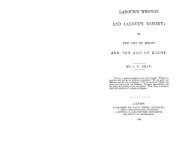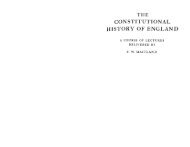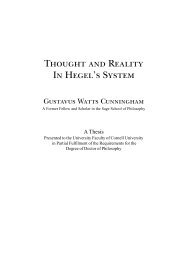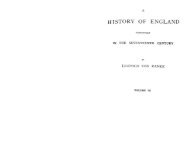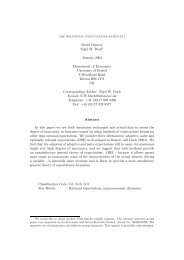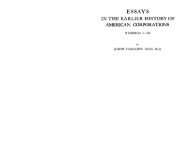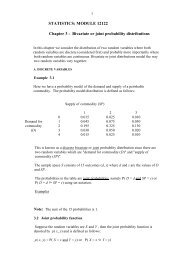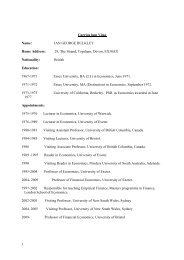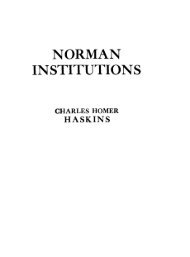4 INTRODUCTORYtragic class <strong>of</strong> wage earners, who, though comparativelyfew in numbers, already constituted a serious problemin the <strong>seventeenth</strong> <strong>century</strong>.In the course <strong>of</strong> the investigation, comparison isfrequently made with the economic position <strong>of</strong> medizval<strong>women</strong> on the one hand, and with <strong>women</strong>'sposition under modern industrial conditions, on theother. It must be admitted, however, that comparisonswith the middle ages rest chiefly on conjecture.Owing to the greater complexity <strong>of</strong> a woman's <strong>life</strong>her productive capacity must be classified on differentlines from those which are generally followed indealing with the economic <strong>life</strong> <strong>of</strong> men,For the purposes <strong>of</strong> this essay, the highest, mostintense forms to which <strong>women</strong>'s productive energyis directed have been excluded ; that is to say, thespiritual creaton <strong>of</strong> the home and the physical creation<strong>of</strong> the child. Though essentially productive, suchachievements <strong>of</strong> creative power transcend the limitations<strong>of</strong> economics and one instinctvely feelsthat there would be something almost degradingin any attempt to weigh them in the balance withproductions that are bought and sold in the market oreven with pr<strong>of</strong>essional services. Nevertheless it mustnever be forgotten that the productive energy whichis described in the ensuing chapters was in no sensealternative to the exercise <strong>of</strong> these higher forms <strong>of</strong>creative power but was employed simultaneously withthem. It may be suspected that the influences <strong>of</strong>home <strong>life</strong> were stronger in the social <strong>life</strong> <strong>of</strong> the<strong>seventeenth</strong> <strong>century</strong> than they are in modern England,and certainly the birth-rate was much higher in everyclass <strong>of</strong> the community except perhaps the very poorest.But, leaving these two forms <strong>of</strong> creative poweraside, there remains another special factor complicating<strong>women</strong>'s economic position, namely, the extent <strong>of</strong> herproduction for domestic purposes-as opposed toindustrial and pr<strong>of</strong>essional purposes. The domesticINTRODUCTORY5category includes all goods and services, either materialor spiritual, which are produced solely for the benefit<strong>of</strong> the family, while the industrial and pr<strong>of</strong>essionalare those which are produced either for sale or exchange.In modern <strong>life</strong> the majority <strong>of</strong> English<strong>women</strong> devotethe greater part <strong>of</strong> their lives to domestic occupations,while men are freed from domestic occupations <strong>of</strong>any sort, being generally engaged in industrial orpr<strong>of</strong>essional pursuits and spending their leisure overpublic services or personal pleasure and amusement.Under modern conditions the ordinary domesticoccupations <strong>of</strong> English<strong>women</strong> consist in tending babiesand young children, either as mothers or servants, inpreparing household meals, and %keeping the houseclean, while laundry work, preserving fruit, and themaking <strong>of</strong> children's clothesare still <strong>of</strong>ten included inthe domestic category. In the seven~enth <strong>century</strong> itembraced a much wider range <strong>of</strong> production ; forbrewing, dairy-work, the care <strong>of</strong> poultry and pigs, theproduction <strong>of</strong> vegetables and fruit, spinning flax andwool, nursing and doctoring, all formed part <strong>of</strong> domesticindustry. Therefore the part which <strong>women</strong> playedin industrial and pr<strong>of</strong>essional <strong>life</strong> was in addition to amuch greater prodoctive activity in the domestic spherethan is required <strong>of</strong> them under modern conditions.On the other hand it may be urged that, if <strong>women</strong>were upon the whole more actively engaged in industrialwork during the <strong>seventeenth</strong> <strong>century</strong> than theywere in the first decade <strong>of</strong> the twentieth <strong>century</strong>,men were much more occupied with domestic affairsthen than they are now. Men in all classes gave timeand care to the education <strong>of</strong> their children, and theyoung unmarried men who generally occupied positionsas apprentices and servants were partly employedover domestic work. Therefore, though now it istaken for granted that domestic work will be done by<strong>women</strong>, a considerable proportion <strong>of</strong> it in former daysfell to the share <strong>of</strong> men.
INTRODUCTORYThese circumstances have led to a different use <strong>of</strong>terms in this essay from that which has generally beenadopted ; a difference rendered necessary from thefact that other writers on industrial evolution haveconsidered it only from the man's point <strong>of</strong> view, whereasthis investigation is concerned primarily with itseffect upon the position <strong>of</strong> <strong>women</strong>.To facilitate the enquiry, organisation for productionis divided into three types :(a) Domestic Industry.(b) Family Industry.(C) Capitalistic Industry, or Industrialism.No hard-and-fast line exists in practice betweenthese three systems, which merge imperceptibly intoone another. In the <strong>seventeenth</strong> <strong>century</strong> all threeexisted side by side, <strong>of</strong>ten obtaining at the same timein the same industries, but the underlying principlesare quite distinct and may be defined as follows :(a) Domestic Industry is the form <strong>of</strong> productionin which the goods produced are for the exclusive use<strong>of</strong> the family and are not therefore subject to anexchange or money value.(b) Family Industry is the form in which thefamily becomes the unit for the production <strong>of</strong> goodsto be sold or exchanged.The family consisted <strong>of</strong> father, mother, children,household servants and apprentices ; the apprenticesand servants being children and young people<strong>of</strong> both sexes who earned their keep and in thelatter case a nominal wage, but who did not expect toremain permanently as wage-earners, hoping on thecontrary in due course to marry and set up in businesson their own account. The pr<strong>of</strong>its <strong>of</strong> family industrybelonged to the family and not to individual members<strong>of</strong> it. During his <strong>life</strong>time they were vested in thefather who was regarded as the head <strong>of</strong> the family ;he was expected to provide from them marriageportions for his children as they reached maturity,INTRODUCTORYand on his death the mother succeeded to hisposition as head <strong>of</strong> the family, his right <strong>of</strong> bestowalby will being strictly limited by custom and publicopinion.Two features are the main characteristics <strong>of</strong> FamilyIndustry in its perfect form ;-first, the unity <strong>of</strong>capital and labour, for the family, whether that <strong>of</strong> afarmer or tradesman, owned stock and tools andthemselves contributed the labour : second, the situation<strong>of</strong> the workshop within the precincts <strong>of</strong> the home.These two conditions were rarely completely fulfilledin the <strong>seventeenth</strong> <strong>century</strong>, for the richerfarmers and tradesmen <strong>of</strong>ten employed permanentwage-earners in addition to the members <strong>of</strong> theirfamily, and in other cases craftsmen no longer ownedtheir stock, but made goods to the order <strong>of</strong> the capitalistwho supplied them with the necessary material.Nevertheless, the character <strong>of</strong> Family Industry wasretained as long as father, mother, and children workedtogether, and the money earned was regarded asbelonging to the family, not to the individual members<strong>of</strong> it.From the point <strong>of</strong> view <strong>of</strong> the economic position<strong>of</strong> <strong>women</strong> a system can be classed as family industrywhile the father works at home, but when he leaveshome to work on the capitalist's premises the lastvestige <strong>of</strong> family industry disappears and industrialismtakes its place.(c) Capitalistic Indurtry, or industrialirm, is thesystem by which production is controlled by theowners <strong>of</strong> capital, and the labourers or producers, men,<strong>women</strong> and children receive individual wages.''The tcrm " individual wages " is used here to denote wages paid either to menor <strong>women</strong> a* individuals, and regarded as belonging to the indikidual person, while"family wages " are those which cover the serricrs nf the nholc family and belongto the family as a whole. This definition differs from the common use <strong>of</strong> the terms,but is necessary for the explanation <strong>of</strong> some important points. In ordinary conversation" individual wages " indicate those which maintain an indi~idual only, while"family wages" are those upon which a family lives. This does not imply a real
- Page 1 and 2: WORKING LIFE OF WOMENIN THESEVENTEE
- Page 8 and 9: 8 INTRODUCTORY INTRODUCTORYDomestic
- Page 10 and 11: INTRODUCTORYunmarried girls go out
- Page 12 and 13: I 6 CAPITALISTS CAPITALISTS" I loos
- Page 14 and 15: CAPITALISTSweak woman stands in the
- Page 16 and 17: 24 CAPITALISTS CAPITALISTS 25wife t
- Page 18 and 19: 2 8 CAPITALISTS CAPITALISTS 29Majes
- Page 20 and 21: 32 CAPITALISTSA warrant was issued"
- Page 22 and 23: CAPITALISTSbusiness. " At O~tend, N
- Page 24 and 25: CAPITALISTS CAPITALISTS41thro' her
- Page 26 and 27: AGRICULTUREwas made of their develo
- Page 28 and 29: AGRICULTUREis not drye as it should
- Page 30 and 31: 52 AGRICULTURE AGRICULTUREhave of h
- Page 32 and 33: 56 AGRICULTUREfor colonists in Virg
- Page 34 and 35: AGRICULTUREmaintain completely the
- Page 36 and 37: 64 AGRICULTUREtime was well spent i
- Page 38 and 39: AGRICULTUREExcept in exeptional cir
- Page 40 and 41: 72 AGRICULTURE AGRICULTURE 73mainta
- Page 42 and 43: 76 AGRICULTUREfor the impotent poor
- Page 44 and 45: AGRICULTUREwhich we can imagine tha
- Page 46 and 47: AGRICULTURE AGRICULTURE 85by his se
- Page 48 and 49: AGRICULTUREher work, but generosity
- Page 50 and 51: AGRICULTUREwife of Thos. Lyne. Toba
- Page 52 and 53: TEXTILESwas paid better than the la
- Page 54 and 55:
TEXTILESroof provided them with the
- Page 56 and 57:
104 TEXTILESformulated by 25 Charle
- Page 58 and 59:
108 TEXTILES TEXTILES 109until the
- Page 60 and 61:
TEXTILESon spinning for their livin
- Page 62 and 63:
TEXTILESstill and dry within Doors,
- Page 64 and 65:
120 TEXTILES TEXTILESthe cloth made
- Page 66 and 67:
124TEXTILES TEXTILESin the closely
- Page 68 and 69:
TEXTILESKingdom, it required a grea
- Page 70 and 71:
132 TEXTILES TEXTILESnot exceedl6 1
- Page 72 and 73:
TEXTILES TEXTILES I37hours in four
- Page 74 and 75:
---P-I 4OTEXTILEScan be quoted of t
- Page 76 and 77:
'44 TEXTILES TEXTILESWood Streate,
- Page 78 and 79:
TEXTILEShigher wages than would hav
- Page 80 and 81:
1 52 CRAFTS AND TRADESdebts. For ex
- Page 82 and 83:
I 56 CRAFTS AND TRADES CRAFTS AND T
- Page 84 and 85:
160 CRAFTS AND TRADES CRAFTS AND TR
- Page 86 and 87:
164 CRAFTS AND TRADESAmong thirty-n
- Page 88 and 89:
CRAFTS AND TRADESalso met with as b
- Page 90 and 91:
172 CRAFTS AND TRADES CRAFTS AND TR
- Page 92 and 93:
176 CRAFTS AND TRADESto Henry Joyce
- Page 94 and 95:
180 CRAFTS AND TRADES CRAFTS AND TR
- Page 96:
CRAFTS AND TRADESWardens and Brothe
- Page 99 and 100:
P-I9OCRAFTS AND TRADESmarriage ; it
- Page 101 and 102:
CRAFTS AND TRADEStaken our goods fr
- Page 103 and 104:
1g8CRAFTS AND TRADESresources turne
- Page 105 and 106:
CRAFTS AND TRADESThere were fewer r
- Page 107 and 108:
206 CRAFTS AND TRADES CRAFTS AND TR
- Page 109 and 110:
CRAFTS AND TRADESA large proportion
- Page 111 and 112:
214CRAFTS AND TRADES CRAFTS AND TRA
- Page 113 and 114:
218 CRAFTS AND TRADES CRAFTS AND TR
- Page 115 and 116:
222 CRAFTS AND TRADES CRAFTS AND TR
- Page 117:
CRAFTS AND TRADES CRAFTS AND TRADES
- Page 120 and 121:
CRAFTS AND TRADESfrom her fellow pa
- Page 122 and 123:
PROFESSIONS 237PROFESSIONSIntroduct
- Page 124 and 125:
24O PROFESSIONS PROFESSIONStheir Th
- Page 126 and 127:
244 PROFESSIONS PROFESSIONS 245the
- Page 128 and 129:
PROFESSIONS PROFESSIONS 249profanat
- Page 130 and 131:
252PROFESSIONSGiles Moore enters in
- Page 132 and 133:
PROFESSIONScribed as one who " dist
- Page 134 and 135:
PROFESSIONS PROFESSIONS 261first ma
- Page 136 and 137:
264 PROFESSIONSGarrett's leg shall
- Page 138 and 139:
268 PROFESSIONSwhere there are none
- Page 140 and 141:
PROFESSIONS PROFESSIONS 273the numb
- Page 142 and 143:
PROFESSIONSexaminations, before six
- Page 144 and 145:
PROFESSIONS PROFESSIONS 281death me
- Page 146 and 147:
284 PROFESSIONS PROFESSIONSof confi
- Page 148 and 149:
288 PROFESSIONSextent they were whe
- Page 150 and 151:
CONCLUSIONor in her other facilitie
- Page 152 and 153:
CONCLUSION CONCLUSION 297in women's
- Page 154 and 155:
CONCLUSIONlaw of Nature, inviolable
- Page 156 and 157:
CONCLUSIONwere specially deprecated
- Page 158 and 159:
308 CONCLUSIONof the State, and the
- Page 160 and 161:
312 AUTHORITIES AUTHORITIES 313Cost
- Page 162 and 163:
AUTHORITIESMartindale, Adam, The Li
- Page 164 and 165:
County.Buckingham ..Cardigan .. ..C
- Page 166 and 167:
INDEXINDEXFlax, 64, 146, 246, 291 ;
- Page 168:
INDEXsmants, women( 50,65,157 ; mam



